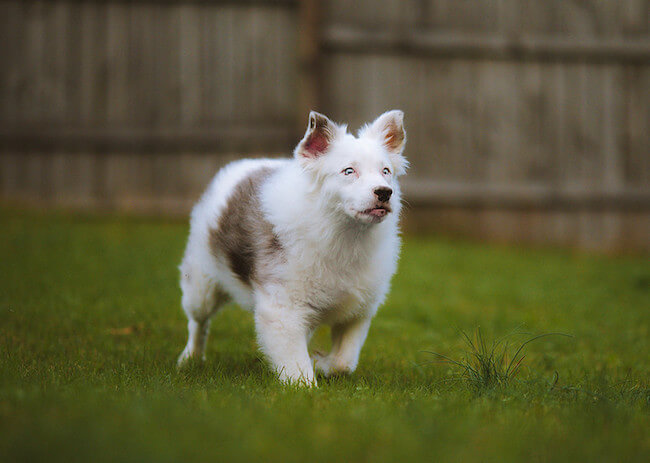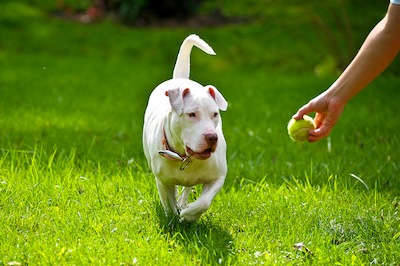Training a Deaf Dog For Safety
While some people think training a deaf dog is impossible, I know that it can be done. The methods used are slightly different than what are used to train a normal dog, but it is overall the same.
Certain breeds are prone to becoming deaf, while some dogs are born that way. In other cases, a disease will cause deafness, or simply old age.
This isn't that much more difficult than training a normal dog. With some helpful tips, your deaf dog can enjoy the same quality of life and wonderful relationship with you as a normal hearing one. As dogs are visual creatures, hand signals will be the main path of communication.
Since he can't hear you, the most important part of training a deaf dog is getting his attention so that you can then give a training hand signal.
You can do this using his other heightened senses - sight,
smell, and touch. Once this "watch me" command is understood by the dog, it opens up the door for all the other signal commands!
An
important thing to keep in mind if you have a deaf dog, is that you can
easily startle him. Don't let children or other adults touch your pooch
until he is aware that they are there, or he might bite out of fear or
being startled.
Putting a sign by the front door or on the gate of your yard to let people know that your dog is deaf will go a long way to preventing any startles.
Dog First
While it does affect almost every part of your dog's life, it's good to remember that first, your dog is a dog. He's not a different creature just because he can't hear. All dogs have certain instincts, and if you drill down even further, each breed has its own specific tendencies and instincts as well. Once you understand that, then you can add the label of "deaf" to your dog.
Being hearing-impaired doesn't give any dog a free pass to do whatever they like. Dog first - dogs shouldn't be barking, jumping up on people, biting, or pulling you down the sidewalk.
If you have a new puppy that is deaf, start by socializing as much as possible! Take him to a puppy class, or make some friends around your neighborhood. All puppies need socialization, and yours is no different!
Training a Deaf Dog: Watch Me
You'll start by simply getting your dog used to checking in periodically by looking at you. No command is needed - all you're going to do is give him a small treat whenever he looks at you. Start by doing this in the house where there are no other distractions.
Use some smelly treats that are high value to your pup - hot dog slices, pieces of cheese, cooked chicken, etc. Something with a lot of smell! Put the treat under his nose so he gets a good sniff, and then pull it away and up to your face. As soon as he makes eye contact with you, pop the treat in his mouth.
If you'd like to incorporate a signal to tell your dog that he's done the right thing and a treat is coming, you can give him a quick thumbs up and then treat immediately.
A few tips:
- keep the bag or stash of treats out of your dog's sight, or he will stare at the location of the treats instead of your eyes.
- once he gets really consistent with the "Watch Me" command, start using the treat less and less as a lure to your face. When eye contact is made, have the treat suddenly appear! You'll also begin treating him every second time, then every three times, and so on, gradually phasing out the treats.
if you'll be using a vibrating collar, the steps are basically the same. When you press the vibrate button and your dog makes eye contact, treat immediately or signal a thumbs up and then give the treat right away.
Training a Deaf Dog to Come
Probably the hardest command to teach a deaf dog is the recall, or come. Not being able to hear you means that you need to have another way to get his attention, particularly if he's not close enough to see a hand signal. One great tool to help with this is a vibrating collar, or "pager", with a remote (NOT an electronic e-collar).
It is not a correction, but simply a vibration on your dog's neck to
get his attention. With some training, he can quickly learn that it
means for him to look at you, so you can signal the command for him to
come. You can also use a certain type of vibration as a come command (i.e. a long vibration or two short ones).
Don't buy into the lie that you will never be able to let your dog off leash. With a lot of patience, hard work and time training a deaf dog, you can get to that point! It is important to remember though, that it may dangerous for a deaf or blind dog to be let off leash close to a busy road.
Separation Anxiety
This is one problem worth shining a spotlight on for a moment. Unfortunately, many deaf dogs and puppies end up at shelters due to their owners not being willing to give the extra effort in training a deaf dog, and give up.
A dog or puppy with a shelter background is much more likely to have separation anxiety. I'm going to come back to what I said at the beginning, though. First, it's a dog. Dogs should always be crate trained, as it teaches them to be calm as well as provides them with a safe place to sleep. Learn more about crate training a dog.
A dog with separation anxiety shouldn't be exempt from this training - on the contrary, crating will both keep your home safe from being destroyed as well as help your dog calm down.
Training a deaf dog will take a little more work on your part, but it can be easily done. There is so much great information available online to help you further with training. I recommend checking out Deaf Dogs Rock (a website specifically about training and living with a deaf dog). There are lots of training and care articles that go into much more detail than I can here.
Finally, enjoy your dog. Special needs pups rely on us for safety and love, and training will only increase that bond you share and make you realize how incredible our furry friends really are!
- Home
- Basic Training
- Deaf Dog Training



